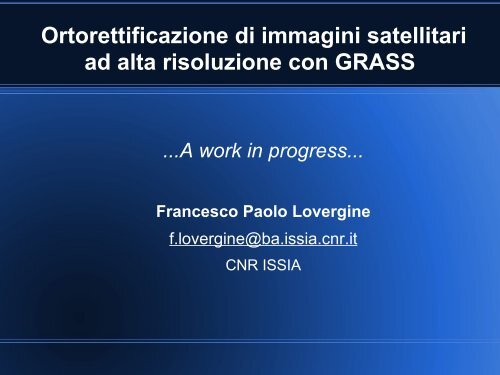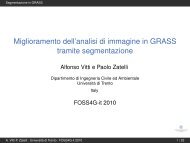Ortorettificazione di immagini satellitari ad alta risoluzione con GRASS
Ortorettificazione di immagini satellitari ad alta risoluzione con GRASS
Ortorettificazione di immagini satellitari ad alta risoluzione con GRASS
Create successful ePaper yourself
Turn your PDF publications into a flip-book with our unique Google optimized e-Paper software.
<strong>Ortorettificazione</strong> <strong>di</strong> <strong>immagini</strong> <strong>satellitari</strong><br />
<strong>ad</strong> <strong>alta</strong> <strong>risoluzione</strong> <strong>con</strong> <strong>GRASS</strong><br />
...A work in progress...<br />
Francesco Paolo Lovergine<br />
f.lovergine@ba.issia.cnr.it<br />
CNR ISSIA
Ortorettifica<br />
È noto che per utilizzare <strong>immagini</strong> <strong>satellitari</strong> in<br />
ausilio alla cartografia è necessario applicare<br />
una procedura <strong>di</strong> correzione geometrica della<br />
deformazione derivante da:<br />
● Rilievo<br />
● Geometria <strong>di</strong> acquisizione<br />
11/02/2010 Lovergine FOSS4G-IT 2010 2
Perché non i.ortho.photo?<br />
Il modulo i.ortho.photo è pensato per<br />
acquisizioni <strong>con</strong> fotocamera (ortofoto) da<br />
aereo, nelle quali la deformazione <strong>con</strong>ica in<br />
prospettiva centrale è il modello <strong>con</strong>solidato.<br />
I moderni sensori “push broom” (es. Ikonos o<br />
Quickbird) hanno una geometria <strong>di</strong><br />
acquisizione più complessa <strong>con</strong> centri <strong>di</strong><br />
proiezione multipli per ogni acquisizione.<br />
11/02/2010 Lovergine FOSS4G-IT 2010 3
Perché non i.rectify?<br />
Un modello polinomiale semplice, quale quello<br />
utilizzato tipicamente per la<br />
georeferenziazione me<strong>di</strong>ante GCP non è<br />
normalmente <strong>ad</strong>eguato in caso <strong>di</strong> variazioni<br />
<strong>di</strong> rilievo significative nel frame da rettificare.<br />
Il problema è particolarmente evidente alla<br />
scala dei satelliti high-res attuali<br />
(~50 cm in pancromatico).<br />
11/02/2010 Lovergine FOSS4G-IT 2010 4
Modelli <strong>con</strong>solidati<br />
Sono stati introdotti e <strong>ad</strong>ottati due modelli <strong>di</strong><br />
ortorettifica per satelliti push broom. Entrambi<br />
richiedono un DEM <strong>di</strong> precisione.<br />
● Modello rigoroso (aka Toutin)<br />
● Modello Rational Functions (RFM)<br />
Ad oggi <strong>GRASS</strong> non ha moduli nativi che<br />
implementino l'ortorettifica satellitare.<br />
11/02/2010 Lovergine FOSS4G-IT 2010 5
Il modello RFM (Grodecki 2001) 1<br />
Rational Functions Model utilizza funzioni <strong>di</strong><br />
trasformazione world-to-image espresse<br />
come rapporto <strong>di</strong> funzioni polinomiali<br />
cubiche.<br />
rn= Pa X n ,Y n , Z n<br />
P b X n ,Y n , Z n =∑i , j ,k =0<br />
rn= P a X n ,Y n , Z 3<br />
n<br />
Pb X n ,Y bijk X<br />
n , Zn n<br />
11/02/2010 Lovergine FOSS4G-IT 2010 6<br />
3<br />
∑i , j ,k =0<br />
3<br />
cn= P c X n ,Y n , Z n<br />
Pd X n ,Y n , Z n = ∑i , j , k=0<br />
3<br />
∑ i , j , k=0<br />
i j k<br />
aijk X nY<br />
n Z n<br />
i j k<br />
Y n Z n<br />
i j k<br />
cijk X n Y n Z n<br />
i j k<br />
d ijk X nY<br />
n Z n
Il modello RFM (Grodecki 2001) 2<br />
Le coor<strong>di</strong>nate world e image si <strong>con</strong>siderano<br />
sempre normalizzate nell'intervallo [-1,1]<br />
me<strong>di</strong>ante una semplice trasformazione<br />
lineare <strong>di</strong> traslazione e scaling<br />
t−t 0<br />
t s<br />
dove t=r ,c , X ,Y , Z<br />
11/02/2010 Lovergine FOSS4G-IT 2010 7
Il modello RFM (Grodecki 2001) 3<br />
Nei modelli RFM associati a satelliti high-res il<br />
set <strong>di</strong> Rational Polinomial Coefficients viene<br />
ridotto a 20 coefficienti per polinomio.<br />
Tali RPC vengono calcolati dal provider<br />
utilizzando un modello rigoroso e ricavando i<br />
coefficienti a partire da un set <strong>di</strong> punti <strong>di</strong><br />
coor<strong>di</strong>nate note (backward transformation).<br />
11/02/2010 Lovergine FOSS4G-IT 2010 8
Il modello RFM (Grodecki 2001) 4<br />
Dato un set <strong>di</strong> RPC calcolati per il frame,<br />
possono essere impiegate le equazioni del<br />
forward model per la ortorettificazione della<br />
immagine.<br />
Il set <strong>di</strong> RPC viene normalmente fornito in un<br />
apposito text file <strong>di</strong> met<strong>ad</strong>ati (formato<br />
custom) in accompagnamento a frame<br />
ortho-re<strong>ad</strong>y georiferiti approssimativamente.<br />
11/02/2010 Lovergine FOSS4G-IT 2010 9
Workflow per l'ortorettificazione 1<br />
I moduli <strong>di</strong> interesse:<br />
● i.group<br />
● i.target<br />
● i.rpc.parse<br />
● i.ortho.rpc (forward)<br />
● i.rpc.calc (backward)<br />
11/02/2010 Lovergine FOSS4G-IT 2010 10
Workflow per l'ortorettificazione 2<br />
i.group e i.target permettono <strong>di</strong> definire<br />
un group <strong>di</strong> raster in location XY e una target<br />
location e mapset per l'ortorettifica.<br />
i.group group= raster=<br />
i.target group= location= mapset=<br />
11/02/2010 Lovergine FOSS4G-IT 2010 11
Workflow per l'ortorettificazione 3<br />
i.rpc.parse nella location XY <strong>di</strong> lavoro<br />
accetta in input un metafile RPC (specifico per<br />
satellite) e produce un file <strong>di</strong> region nella target<br />
location/mapset e un file RPC nel group<br />
precedentemente creato.<br />
i.rpc.parse group= region= input= \<br />
type=<br />
11/02/2010 Lovergine FOSS4G-IT 2010 12
Workflow per l'ortorettificazione 4<br />
i.ortho.rpc effettua l'ortorettifica nella target<br />
location e mapset dello specifico group,<br />
utilizzando il relativo file RPC, nella region<br />
(minima) specificata nel passo precedente.<br />
Occorre passare il DEM relativo.<br />
i.ortho.rpc group= output= \<br />
[ north= south= east= west= res= ] \<br />
dem= [ shift= ]<br />
11/02/2010 Lovergine FOSS4G-IT 2010 13
Todo<br />
● RPC parsing template-based per aggiungere<br />
più facilmente nuovi satelliti.<br />
● Interpolazione DEM (attualmente NN)<br />
● i.rpc.calc numericamente stabile<br />
● Integrazione calcolo shift me<strong>di</strong>o?<br />
● Code cleaning<br />
11/02/2010 Lovergine FOSS4G-IT 2010 14
KOMPSAT2 Umbria<br />
● KOMPSAT2 è un satellite coreano SPOT5like<br />
<strong>con</strong> <strong>risoluzione</strong> 1m in pancromatico, 4m<br />
in multispettrale (RGBN).<br />
● Dataset: doppio frame mosaicato<br />
● DEM 25m<br />
● Processing: ortorettifica+georiferimento <strong>con</strong><br />
1 GCP.<br />
● Proiezione UTM33 ED50<br />
11/02/2010 Lovergine FOSS4G-IT 2010 15
KOMPSAT2 Umbria<br />
11/02/2010 Lovergine FOSS4G-IT 2010 16
KOMPSAT2 Umbria<br />
11/02/2010 Lovergine FOSS4G-IT 2010 17
KOMPSAT2 Umbria<br />
11/02/2010 Lovergine FOSS4G-IT 2010 18
KOMPSAT2 Umbria<br />
La doppia procedura <strong>con</strong>sente <strong>di</strong> ottenere un<br />
RMS su GCP <strong>di</strong> 1.9m, quin<strong>di</strong><br />
sostanzialmente in linea <strong>con</strong> i risultati<br />
<strong>di</strong>chiarati in letteratura, nonostante il DEM a<br />
<strong>risoluzione</strong> non <strong>con</strong>frontabile.<br />
Qualitativamente è anche accettabile il<br />
risultato del <strong>con</strong>fronto fra la CTR e<br />
l'immagine in mancanza <strong>di</strong> ulteriori parametri.<br />
11/02/2010 Lovergine FOSS4G-IT 2010 19
Question time<br />
<br />
11/02/2010 Lovergine FOSS4G-IT 2010 20



